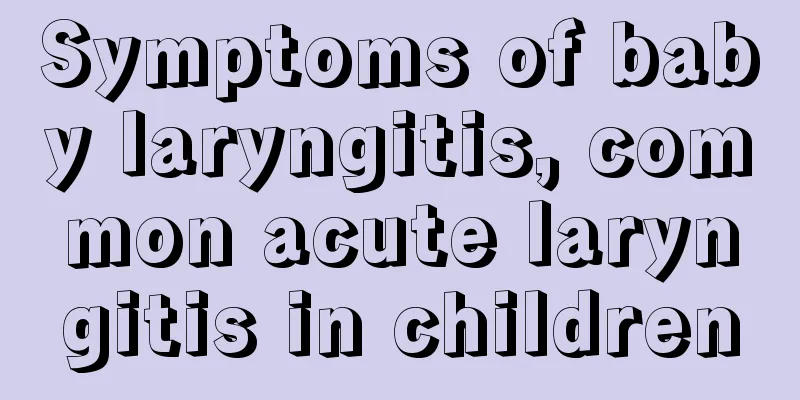Symptoms of baby laryngitis, common acute laryngitis in children

|
The most common type of laryngitis in babies is acute laryngitis in children. This disease develops very quickly and can cause fever, congestion in the throat, and hoarseness. The symptoms are more obvious at night. For acute laryngitis in children, we must take good care of them and increase their outdoor activities. 1. Symptoms of baby laryngitis
1. It is more common in young children and has an acute onset. 2. There may be varying degrees of fever, hoarseness, barking cough and inspiratory stridor. 3. The throat is congested, the false vocal cords are swollen, and the subglottic mucosa is swollen in a fusiform shape. 4. The symptoms are milder during the day, but worsen at night due to relaxation of throat muscles and blockage of secretions after falling asleep. 5. Laryngeal obstruction is divided into the following 4 degrees: Grade I: The patient is like a normal person at rest, but inspiratory gurgling and dyspnea occur only after activity. The lungs had clear breath sounds and the heart rate was unchanged. Grade II: Laryngeal stridor and inspiratory dyspnea occur even at rest. Laryngeal conduction sounds or tubular breath sounds may be heard upon auscultation of the lungs, and the heart rate is relatively fast. Grade III: In addition to the symptoms of grade II laryngeal obstruction, the patient becomes irritable, has cyanosis of the lips, fear and sweating due to lack of oxygen. Lung auscultation revealed significantly decreased breath sounds, dull heart sounds, and increased heart rate. Grade IV: After struggling with breathing difficulties, the patient gradually becomes exhausted and drowsy. Due to the inability to breathe, the patient is temporarily quiet and the three-depression sign is not obvious, but his face is pale and gray. When auscultating the lungs, the breath sounds almost disappear completely, leaving only tracheal conduction sounds, dull heart sounds, and irregular heart rate, either fast or slow. Physical examination: congestion in the throat, swelling of the false vocal cords, and fusiform swelling of the subglottic mucosa. Depending on the severity of the lesion, laryngeal striae and inspiratory dyspnea may sometimes occur, and laryngeal conduction sounds or tubular breath sounds may be heard upon auscultation of the lungs. 2. Nursing of acute laryngitis in children 1. Increase outdoor activities, get more sunlight, strengthen your physical fitness, and improve your disease resistance. 2. Pay attention to climate changes, add or remove clothes in time to avoid cold or heat. 3. During the cold epidemic, try to reduce going out to prevent infection. 4. Live a regular life, eat in moderation, have regular daily routines, go to bed at night and get up early to avoid catching a cold. Avoid cross drafts while sleeping. |
<<: What causes laryngitis in babies? Viral infection is the most common
>>: Children's sensitive period at various stages, let you understand children better
Recommend
What to do if your baby has teething
Teething is an important milestone in a baby'...
24-month-old baby development indicators and standards
A 24-month-old baby is already in the age group o...
4-year-old baby education
Nowadays, many parents pay special attention to t...
What should a 5-year-old child with poor resistance eat?
Children have poor resistance, so try not to take...
What should I do if my child has Gan Ji?
The so-called malnutrition actually refers to the...
Can a five month old baby sit?
When a baby is born, his bones are relatively fra...
How to treat drooling in children with cerebral palsy
Drooling in children with cerebral palsy can have...
Causes of inverted nipples in girls
Nipples are an important symbol of women, and fir...
What should I do if my child has a fever of 37.5 degrees?
After the child is born, many new mothers will wo...
How to relieve a child’s fever of 39 degrees?
Recently there was a report in the UK that a chil...
What causes polio? Let you know the truth!
Polio is a disease that is more likely to be caus...
How to prevent children from having fever and convulsions?
When a child has a fever, it is still easy to cau...
Is it normal for a child's head to sweat a lot?
Children must be busy jumping around every day. O...
How to make baby eyelashes longer
Newborn babies are always adorable, especially th...
What to do if baby eczema is scratched and bleeds
The chance of skin diseases like eczema occurring...









